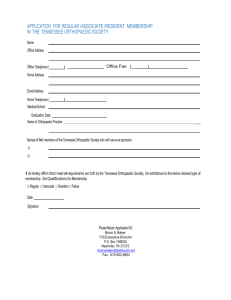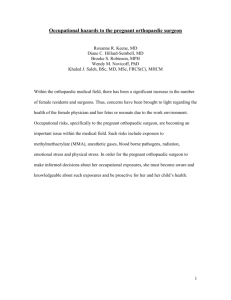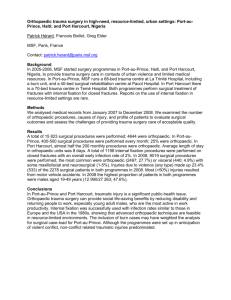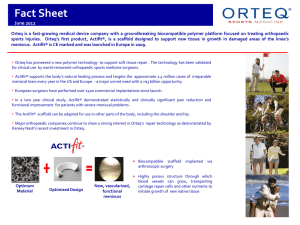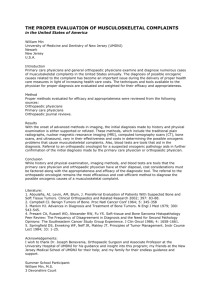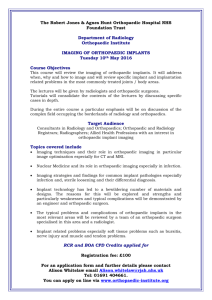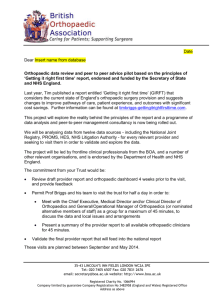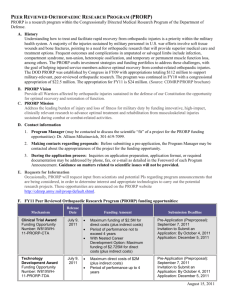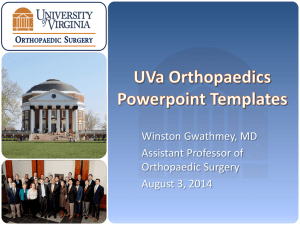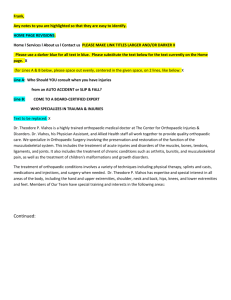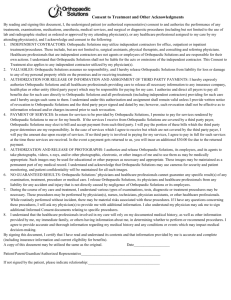Orthopedic Surgery Course Overview
advertisement
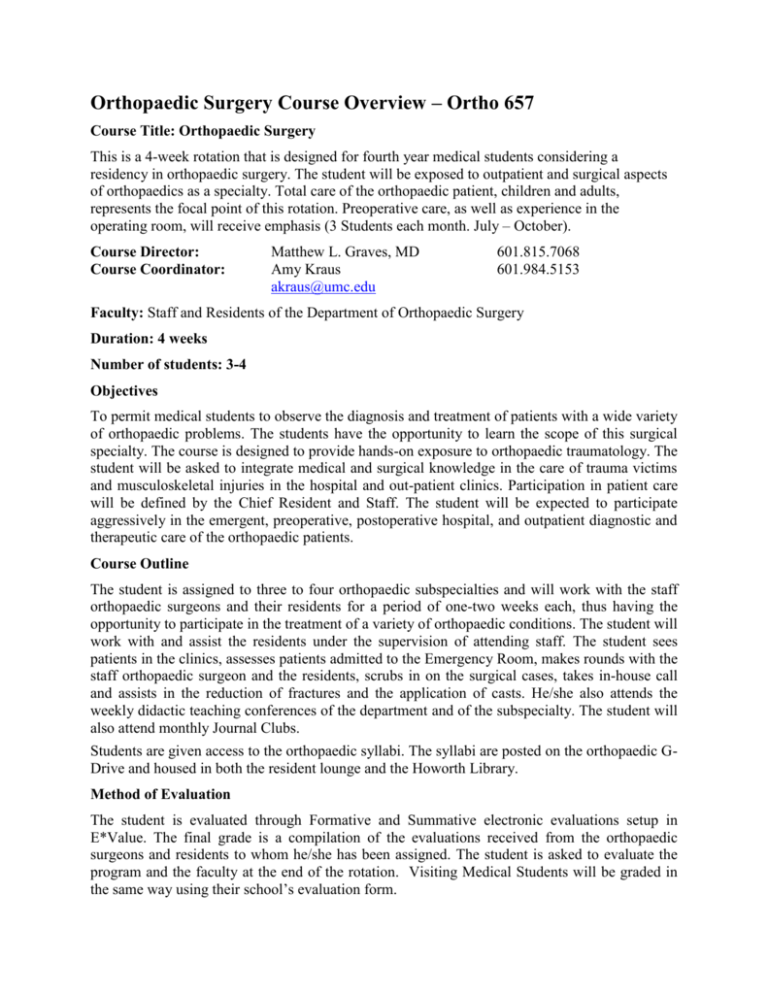
Orthopaedic Surgery Course Overview – Ortho 657 Course Title: Orthopaedic Surgery This is a 4-week rotation that is designed for fourth year medical students considering a residency in orthopaedic surgery. The student will be exposed to outpatient and surgical aspects of orthopaedics as a specialty. Total care of the orthopaedic patient, children and adults, represents the focal point of this rotation. Preoperative care, as well as experience in the operating room, will receive emphasis (3 Students each month. July – October). Course Director: Course Coordinator: Matthew L. Graves, MD Amy Kraus akraus@umc.edu 601.815.7068 601.984.5153 Faculty: Staff and Residents of the Department of Orthopaedic Surgery Duration: 4 weeks Number of students: 3-4 Objectives To permit medical students to observe the diagnosis and treatment of patients with a wide variety of orthopaedic problems. The students have the opportunity to learn the scope of this surgical specialty. The course is designed to provide hands-on exposure to orthopaedic traumatology. The student will be asked to integrate medical and surgical knowledge in the care of trauma victims and musculoskeletal injuries in the hospital and out-patient clinics. Participation in patient care will be defined by the Chief Resident and Staff. The student will be expected to participate aggressively in the emergent, preoperative, postoperative hospital, and outpatient diagnostic and therapeutic care of the orthopaedic patients. Course Outline The student is assigned to three to four orthopaedic subspecialties and will work with the staff orthopaedic surgeons and their residents for a period of one-two weeks each, thus having the opportunity to participate in the treatment of a variety of orthopaedic conditions. The student will work with and assist the residents under the supervision of attending staff. The student sees patients in the clinics, assesses patients admitted to the Emergency Room, makes rounds with the staff orthopaedic surgeon and the residents, scrubs in on the surgical cases, takes in-house call and assists in the reduction of fractures and the application of casts. He/she also attends the weekly didactic teaching conferences of the department and of the subspecialty. The student will also attend monthly Journal Clubs. Students are given access to the orthopaedic syllabi. The syllabi are posted on the orthopaedic GDrive and housed in both the resident lounge and the Howorth Library. Method of Evaluation The student is evaluated through Formative and Summative electronic evaluations setup in E*Value. The final grade is a compilation of the evaluations received from the orthopaedic surgeons and residents to whom he/she has been assigned. The student is asked to evaluate the program and the faculty at the end of the rotation. Visiting Medical Students will be graded in the same way using their school’s evaluation form. Grading Scale based on Core Competencies Patient Care Medical Knowledge Practice-Based Learning Interpersonal & Communication Skills Professionalism System-Based Practice TOTAL 16.6 % 16.6 % 16.6 % 16.6 % 17.0 % 16.6 % 100 % Professional Demeanor and Appearance It is expected that the demeanor and personal appearance of the medical student will reflect quality professionalism and pride in all the roles in which the student finds himself or herself. In addition to the student’s clinical skills and technical abilities, the way we “present” to other people is the crucial element in earning the confidence and respect that is so important to successful patient and professional relationships. The following practices should be observed: Dress 1. A coat and tie or professional attire must be worn at all times, including weekend with the exception of night call. Bloody athletic shoes are not considered acceptable attire. 2. O.R. dress code will be strictly adhered to. Conduct 1. Attendance is expected at all scheduled conferences and clinics unless specifically excused by the Chief Resident or Staff. 2. Hospital rules for smoking will be observed. In addition, simple courtesies such as no gum chewing or eating during patient contact or while presenting are observed. 3. Everyone with whom the student comes in contact is to be treated courteously. Do not respond to irritating behavior with an angry response; nothing positive is accomplished. Rather, submit the problem areas to the Chief Resident or Staff as appropriate. 4. Do not take up personal vendetta with any office, position or person. Be honest and candid and use sound judgment and discretion. When we fail in our interpersonal contacts, the best remedy is to seek forgiveness. It is professional and reflects mature character to say “I’m sorry”. 5. Be especially courteous to nurses and ancillary personnel. Core Competencies Patient Care Student will gain abilities to evaluate patients with musculoskeletal injuries. Students must be able to provide patient care that is compassionate, appropriate, and effective for the treatment of health problems and traumatic injuries. Students are expected to demonstrate an understanding and delivery of basic patient care including respect for patient autonomy and appropriate bedside manner. They will be expected to generate patient lists for the services assigned, and use these lists to develop comprehensive assessments and plans for patients admitted to the services. All should be able to recognize critical lab abnormalities or clinical situations that will require a higher level of care. Medical Knowledge Student will gain knowledge in anatomy; and fracture management principles and outcomes. Students must demonstrate knowledge of established and evolving biomedical, clinical, epidemiological, and socialbehavioral sciences, as well as the application of this knowledge to patient care. Practice- Based Learning and Improvement Students must demonstrate the ability to investigate and evaluate the care of patients, to appraise and assimilate scientific evidence, and to continuously improve patient care based on constant self-evaluation and life long learning. Students are expected to develop skills and habits to be able to: Identify strengths, deficiencies and limits in one’s knowledge and expertise; Set learning and improvement goals Use information technology to optimize learning All students will be expected to be “active learners,” asking questions routinely on rounds and demonstrating incorporation of new knowledge into their patient care plans. They will be expected to demonstrate regular use of the medical literature in determining evidence basis for recommended therapies in a variety of orthopedic clinical scenarios. All students will be expected to answer clinical questions through use of available electronic resources. Systems Based Practice Students must demonstrate an awareness of and responsiveness to the larger context and system of health care, as well as the ability to call effectively on other resources in the system to provide optimal health care. Students are expected to coordinate patient care within the health care system relevant to the care of the orthopedic patient. Incorporate considerations of cost awareness and risk-benefit analysis in patient care. Work in interprofessional teams to enhance patient safety and improve patient care quality. Professionalism Students must demonstrate a commitment to carrying out professional responsibilities and an adherence to ethical principles. Students are expected to demonstrate: Compassion, integrity, and respect for others Responsiveness to patient needs that supersedes self-interest Respect for patient privacy and autonomy Sensitivity and responsiveness to a diverse patient population, including but not limited to diversity in gender, age, culture, race, religion, disabilities, and sexual orientation Interpersonal and Communication Skills Students must demonstrate interpersonal and communication skills that result in the effective exchange of information and teaming with Residents and Staff. Students will gain an appreciation of the importance of good communication skills with patients with musculoskeletal complaints.
